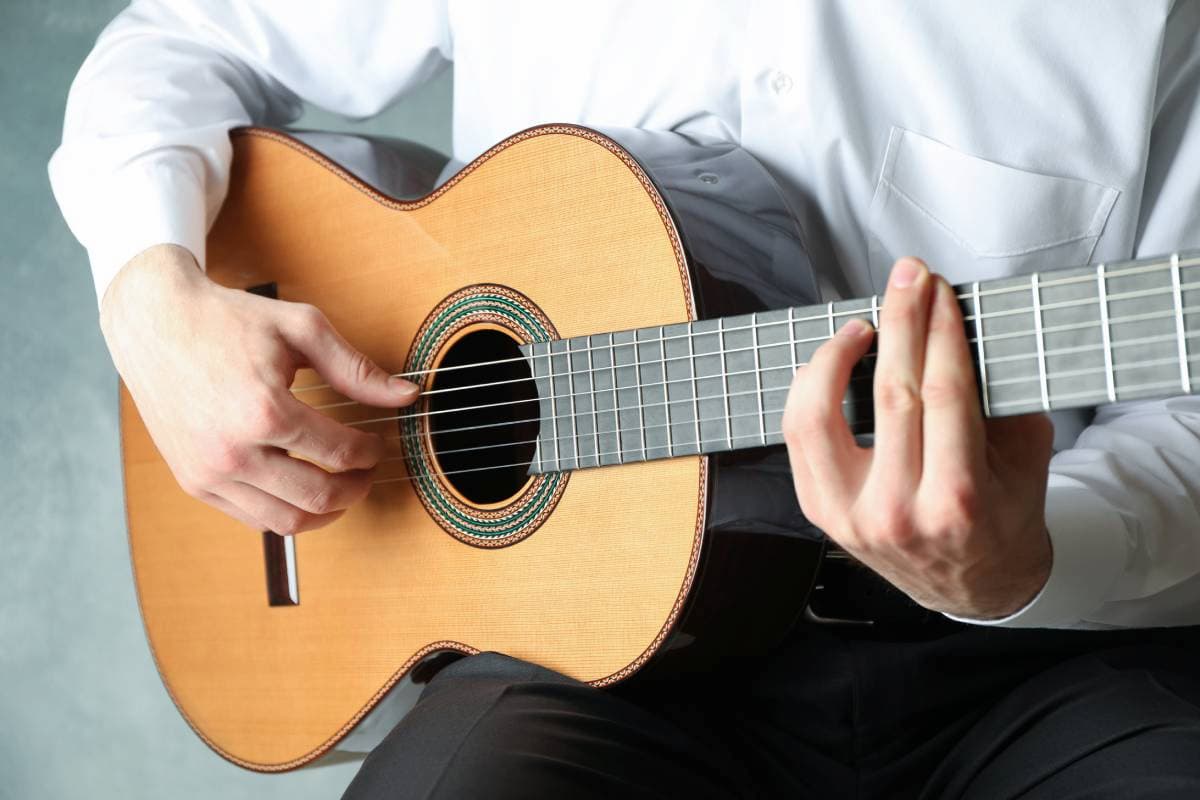Guitar pickups are excellent when it comes to boosting the vibrations of guitar strings to audible volumes, so the instrument can be heard over drums and across a club, concert hall, or stadium. Unfortunately, a noisy pickup can cause humming or buzzing that can ruin the sound of a guitar and, along with it, the listening and playing experience for the musician and the crowd. Luckily, there are a few approaches you can try to solve this issue.
Here are the seven best ways to deal with noisy guitar pickups:
- Shield your guitar and the pickups.
- Use a hum eliminator pedal.
- Invest in a high-quality noiseless pickup.
- Adjust your power source.
- Eliminate ground loops with a transformer.
- Change the location of the pickup.
- Use an equalizer pedal.
In the rest of this article, I’ll explain each of these methods in more detail to help you fix a noisy guitar pickup in no time. Therefore, if you’re tired of dealing with the hums and unwanted noises of some guitar pickups and are looking for ideas on how to achieve a better and more consistent sound, keep reading until the end.
👇😀👇NOTE👇😀👇
If you want to find out what my recommended guitar gear is, then here is what I recommend on Amazon:
- Fender Cutaway Acoustic-Electric Guitar Bundle (MY FAVORITE GUITAR)
- Snark SN-8 Super Tight All Instrument Tuner (Easiest Tuner I’ve Used😏)
- 6 String Acoustic Guitar Capo (Best CAPO for quick changes)
- Dunlop Max Grip 1.0mm Nylon Picks (Thick Guitar Pick So You Don’t Lose Grip!)
- Universal Guitar Stand (Cheap & Minimalist Guitar Stand I Recommend)
- Levy’s 2″ Wide Quick Adjust Guitar Strap (Best Guitar Strap For Any Level)
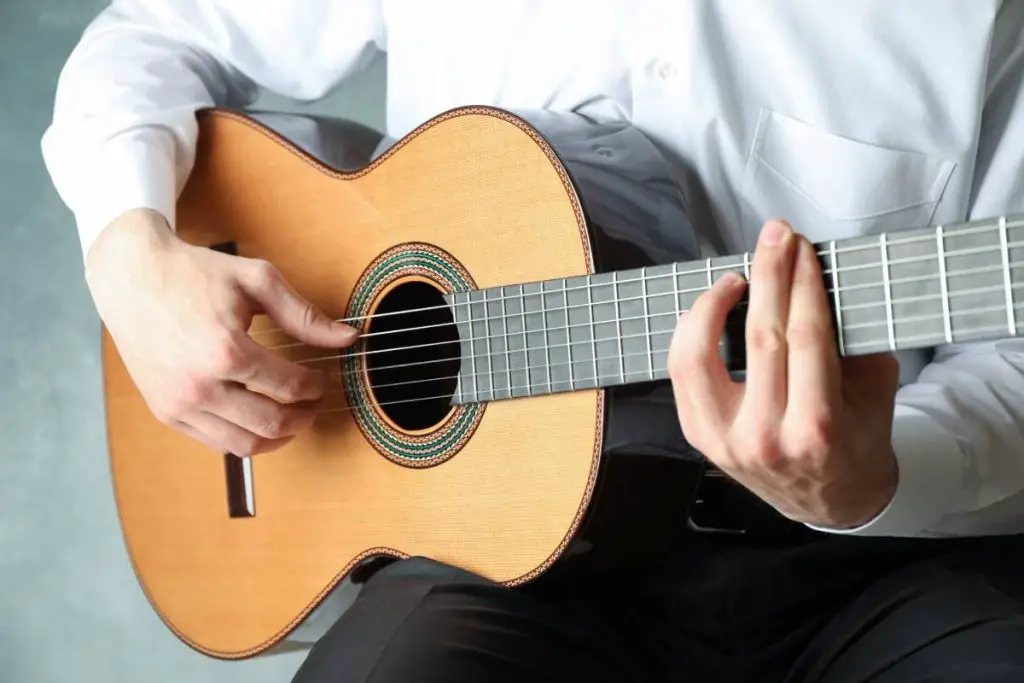
1. Shield Your Guitar and the Pickups
Alternating the sound current in power wiring generates electric and magnetic fields that oscillate at 60 Hz. These magnetic fields can couple to the guitar wiring and cut the conductors in the pickup, at which point the humming is amplified by the amp.
Single-coil pickups are prone to picking up unwanted hums and noises, which can be extremely distracting for both the player and the crowd. One way to deal with this is to create a shield for the pickups.
Before you can create a shield for the pickups, you’ll need the following materials:
- Conductive, self-adhesive copper tape
- Self-adhesive pickup-coil tape
- Solid-core wire
- Naphtha
My favorite copper tape is Eyech 3 Sizes Copper Foil Tape Conductive Self Adhesive Copper Tape from Amazon.com. It’s waterproof, cold-resistant, and extremely sticky, so you don’t have to worry about the tape peeling off. Additionally, it is suitable for guitar repairs, shielding, and electrical repairs, so you can use it for more than just your pickup shield.
As for pickup-coil tape, I like the EZlifego Double Sided Tape on Amazon. This tape is made from the latest acrylic-gel material, and it is extremely strong and durable. The tape sticks well in temperatures from zero degrees Fahrenheit up to two-hundred degrees Fahrenheit (-18 to 93 degrees Celsius).
Once you have all the necessary materials, you’re ready to build your shield around the pickup. First, protect the windings by wrapping pickup-coil tape around them. If you leave the windings unprotected, you’ll be putting copper tape directly on them. This can be dangerous because the back of the copper tape is conductive, so any damage will result in the pickup shorting out.
After covering the windings, wrap the copper tape around the pickup. You should be careful not to have any overlap, so leave a little gap between the ends of the tape, so your pickup doesn’t lose its highs. This gap is best located on the opposite side from where the two tires are attached.
If the two ends of the copper tape touch each other, your pickup will lose all of its high ends. The gap breaks the eddy currents in the film, which means you won’t lose any of the high end.
Then, you need to connect the copper tape to the pickup’s ground. To do this, use solid core wire and put it in the spot where the pickup wire connects to the base.
Finally, use naphtha to clean part of the copper tape, so it is easier to solder the wire to the tape. Wait for the naphtha to dry, and then affix the wire to the tape. I recommend the Klean-Strip VM&P Naphtha Thins Enamels & Varnish from Amazon. This is a strong solvent that is sufficient for cleaning all kinds of oily and waxy surfaces. I also like that this naphtha is low-odor since some varieties have an extreme distracting odor.
This shield is an effective way to reduce the exposure the single-coil pickup has to unwanted noise sources. The copper tape is conductive and will harness any external noise so it doesn’t reach the pickup.
Alternatively, you can use aluminum tape instead of copper tape, or you can use shielding paint. I recommend this MG Chemicals 843WB Super Shield Water Based Silver Coated Copper Paint from Amazon. This paint provides EMI shielding over many frequencies and is a ready-to-use system, so you don’t have to worry about diluting the solution before using it to shield your pickup.
Shielding a pickup helps reduce unwanted interference and humming sounds, especially for single-coil pickups.
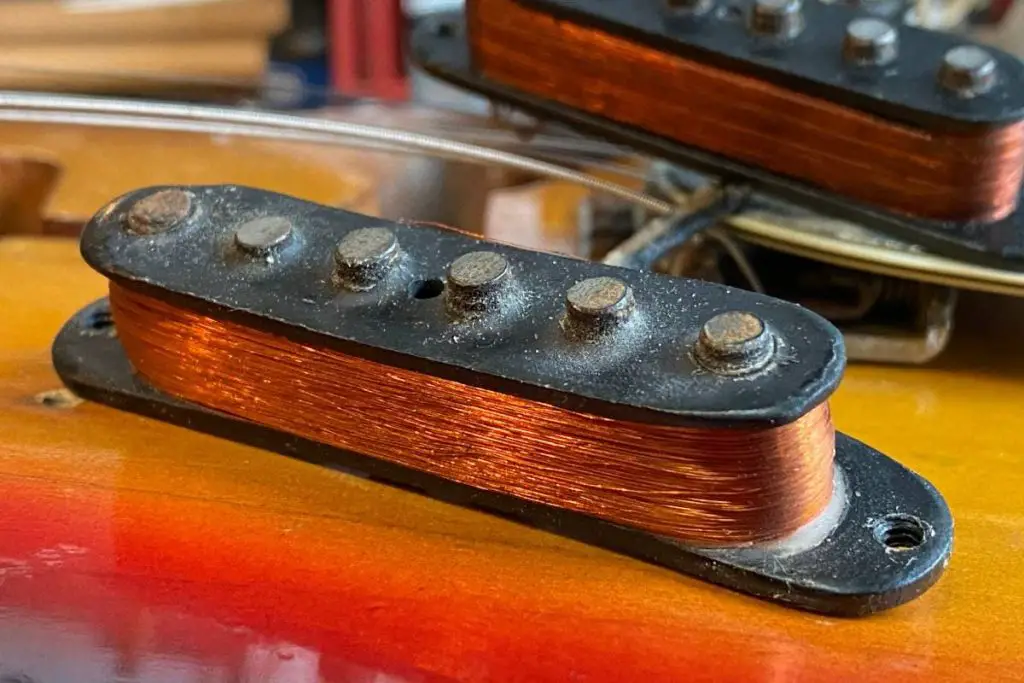
2. Use a Hum Eliminator Pedal
Another excellent way to deal with a noisy guitar pickup is to get a hum eliminator pedal. This is a good option for those who don’t want to acquire the materials for a shield and create the shield itself.
Hum eliminator pedals balance the signal and give the sound a more potent and clear tone. They also effectively disrupt hum and buzz, especially 60Hz cycle hums. These pedals work with a variety of pickups and help clean up the signal so the hum cannot overtake the guitar’s sound.
My favorite hum eliminator is the Ebtech Hum Eliminator from Amazon.com. This tool uses 1:1 isolation transformers to balance audio lines and break loop antennas. It can also convert balanced and unbalanced signals and cable types. Finally, I like that the jacks can accept nearly any combination of plugs.
3. Invest in a High-Quality Noiseless Pickup
Single-coil pickups are not effective for canceling out 60 cycle hums, and sometimes the only way to deal with a noisy guitar pickup is to invest in a higher-quality option. Noiseless pickups can deliver great tone without interfering with your sound, so if you have a noisy guitar pickup, it may be time for an upgrade.
These pickups use two wire coils to cancel out external noise by pairing a coil with the north side of the magnets pointed up and another coil with the south side of the magnets pointed up. This reduces noise interference via phase cancellation, as the magnets are in opposite polarity.
In general, noiseless pickups produce warmer and darker tones than regular single-coils. Furthermore, noiseless pickups work better with distorted sounds, whereas single-coil pickups work better with clean sounds. However, you can still get twangy sounds from these pickups, so don’t expect any wonders. Still, noiseless pickups consistently produce better sound, so they’re a worthy investment.
The following table outlines my recommendations for high-quality noiseless pickups: All links are from Amazon.
| Pickup | Why I Recommend It |
| Fender Generation 4 Noiseless Stratocaster SIngle-Coil Pickups | Authentic vintage-style Fender tone Noise-free performance Crisp, clear, and overdriven tones Tight low end Clearly defined high end Punchy mids |
| EMG S Ceramic Single Coil Active Pickup | Strings have great balance Strings can be changed easily, even by beginners Great sound quality High output Can be used as neck and bridge pickups |
| EMG SA Active Single Coil Guitar Pickup | Superior corrosion resistance High-quality magnets improve sound clarifying performance Low output resistance High-frequency response Great sustain |
| Fender Strat Hot Noiseless Pickups | Affordable price Clear tone Well-balanced Solderless and easy to install Aged white color provides a vintage look |
| Lovermusic Ceramic Magnet Pink Purple Noiseless Electric Guitar Humbucker Bridge Neck Pickup Set | Extremely affordable Interesting color Well-balanced Clear tone Great sound quality Easy to install |
If you’re fed up with your noisy pickup, any of the above alternatives would be a great replacement.
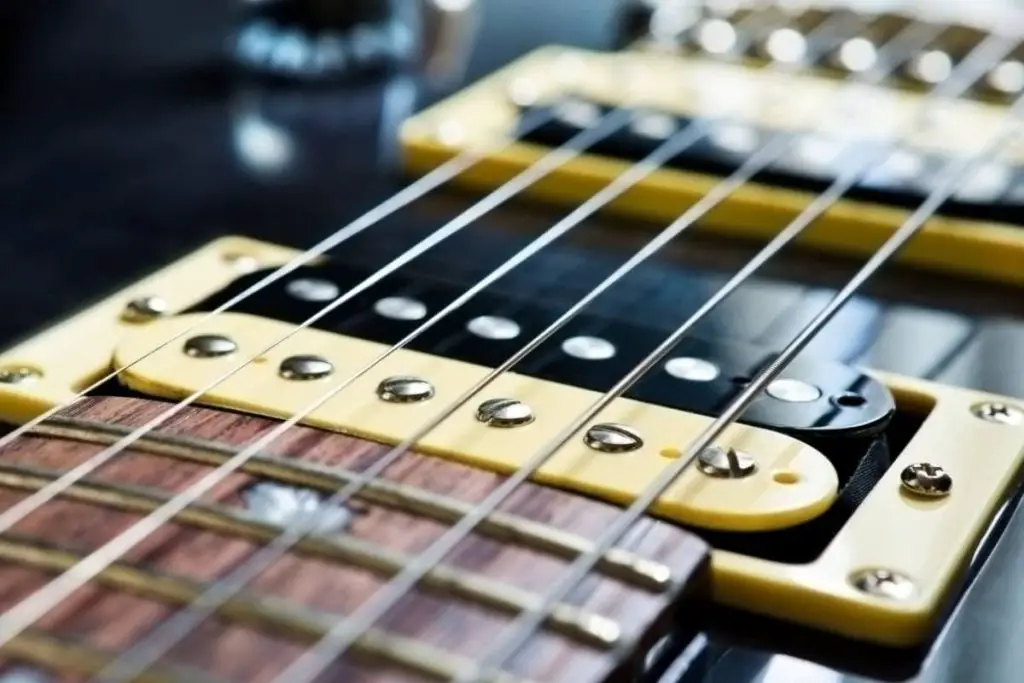
4. Adjust Your Power Source
Most electrical systems that you’ll use for your guitar rig setup employ three conductors. When attaching two amplifiers together, a ground loop can form, which causes humming and buzzing. A ground loop occurs when two parts of a circuit are supposed to have the same ground reference potential, but the potentials are actually different.
This problem can be caused by various issues, including different voltages between two amps, stray voltages, or problems with the wiring.
Some facing this problem may be tempted to remove the safety ground, but I do not recommend doing so. Removing safety grounds is illegal and unsafe. Instead, a better option would be to connect your amps, pickups, and effects to a common power bar or a rack-mount power source and a surge protector.
I highly recommend the Belkin Power Strip Surge Protector from Amazon, as it offers twelve AC outlets with a surge protector, allowing you to plug in all your sound equipment and ensure that it is all wired to the same electrical phase. Additionally, the strip has a 3,940 Joule energy rating, which will secure your electronics from overload, short circuits, power spikes, lightning strikes, and fluctuations.
5. Eliminate Ground Loops With a Transformer
In audio systems, there are two grounds: the electrical safety ground and the audio ground. Pickups join these grounds together, which creates a ground loop. Ground loops can cause unwanted and annoying humming. The best way to solve this issue is to eliminate the ground loop altogether using a transformer.
A transformer causes a current to go into the primary coil and transform into a magnetic field. At this point, the transformer guides the magnetic field into the secondary coil. This way, the input and the output are bridged magnetically and not connected. As a result, the humming sound will be greatly reduced because transformers pass alternating currents and not direct ones.
I recommend the Radial Engineering JDI Passive Direct Box from Amazon.com. These transformers use nickel core materials, ultra-thin wires, and various shields to transfer the signal without humming and buzzing. By using them, you’ll be able to effectively avoid harmonic distortion and phase.
6. Change the Location of the Pickup
The power wiring in any room generates electric fields that oscillate at 60 Hz, and when the magnetic lines cut the conductors in the pickup, the 60 Hz signal is amplified by the amp. One simple way to fix this is to adjust the angle between the pickup coil wires and the magnetic field.
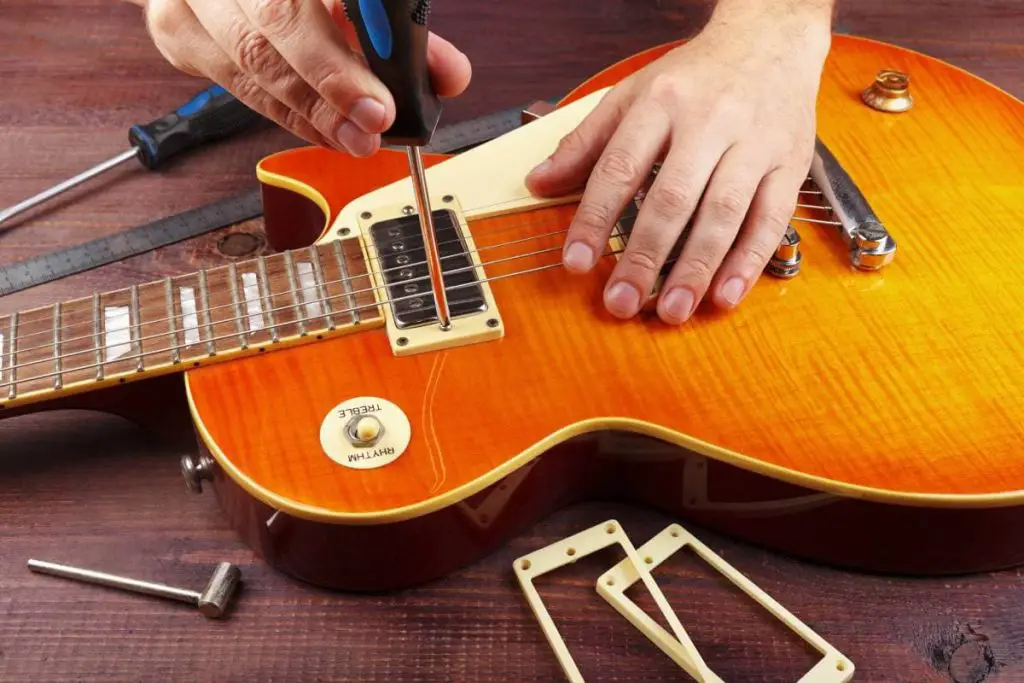
You may find that the hum goes away if the pickup is in certain positions because the angle between the pickup wires and the magnetic field was adjusted. Therefore, one way to deal with a noisy pickup is to try different spots and angles when placing your equipment. The best location for a pickup is close to the fretboard, and the closer to the fretboard, the better.
7. Use an Equalizer Pedal
A guitar equalizer pedal can correct the response of a noisy pickup, while also providing a wide range of other benefits, so it is a useful piece of equipment to have in your sound setup. Equalization pedals adjust the amplitudes of the frequencies within a guitar, and they can help balance the guitar’s sound by adjusting the frequency ranges. This improves the overall sound and helps eliminate the issues that arise when using a noisy pickup.
Equalization adjusts the balance of audible frequencies by raising some and lowering others. Furthermore, an equalizer pedal can completely remove some frequencies, which is helpful when you’re trying to make up for a less-than-ideal pickup (relevant article: how to get distortion on guitar without a pedal).
In addition to helping with a noisy pickup, an equalizer pedal provides the following benefits:
- Corrects the response of noisy transducers, such as microphones and loudspeakers
- Eliminates unwanted noise from signals
- Mitigates feedback
- Improves the sonic character of a guitar
- Removes low-end noise
- Reduces problem frequencies
- Reduces standing-wave frequencies
- Improves overall mix
Equalizer pedals can be analog, digital, fixed-frequency, graphic, parametric, or semi-parametric. When placed in a guitar rig, they can clean up the tone and the sound by balancing the frequency appropriately.
The three most common types of equalizer pedals are:
- Graphic. Graphic pedals have set frequency points and amplitude sliders that you can use to adjust frequency levels.
- Parametric. These pedals allow users to set multiple frequency values for lows, low-mids, high-mids, and highs.
- Semi-parametric. These pedals are similar to parametric pedals, but they do not provide the same functionality. These pedals include typical bass, mids, and treble adjustments.
A properly used and high-quality equalizer pedal can eliminate the issues associated with noisy guitar pickups and various other issues. Here are some of my suggestions for the best equalizer pedals on the market. All links are to Amazon.
- Orange Custom Shop Bax Bangeetar Guitar Pre-EQ Effects Pedal. This pedal has a wide gain range, so it can adjust even large distortion levels. Additionally, the no-diode clipping helps this pedal respond like an amp, giving you the best control and sound quality. I also like the ultra-transparent buffered bypass.
- MXR M108S Ten Band EQ Guitar Effects Pedal. This pedal can cut or boost up to ten different frequencies. I also like the LEDs, which allow for high visibility, even in direct sunlight or bright fluorescent light conditions. Finally, this pedal has two outputs that allow two separate signal chains to run.
- Wampler EQuator Advanced Audio Equalizer Guitar Effects Pedal. This pedal has fixed bass and treble controls and two semi-parametric mid controls that are easy to adjust through the handy twisting knobs. The defined frequencies have their sweet spots marked, and the pedal features precise frequency control and ample output. The high-grade components are selected for their superior response and sound.
- BOSS Seven-Band Graphic Equalizer Guitar Pedal. I like this pedal because it produces a wide range of tones, so it is similar to having several amps. The best way to use this pedal is to cut the frequencies you don’t want and then use the straightforward level slider to compensate if you notice a drop in overall volume.
If you’ve never used an equalizer pedal before, you may find it a bit difficult. The first thing you should know is that it is best to start by filtering out low frequencies first. If you’re concerned about this ruining the sound of your guitar, you’re not alone. However, a lot of the tone of a guitar comes from its harmonic profile, so listeners will fill in low-end tones.
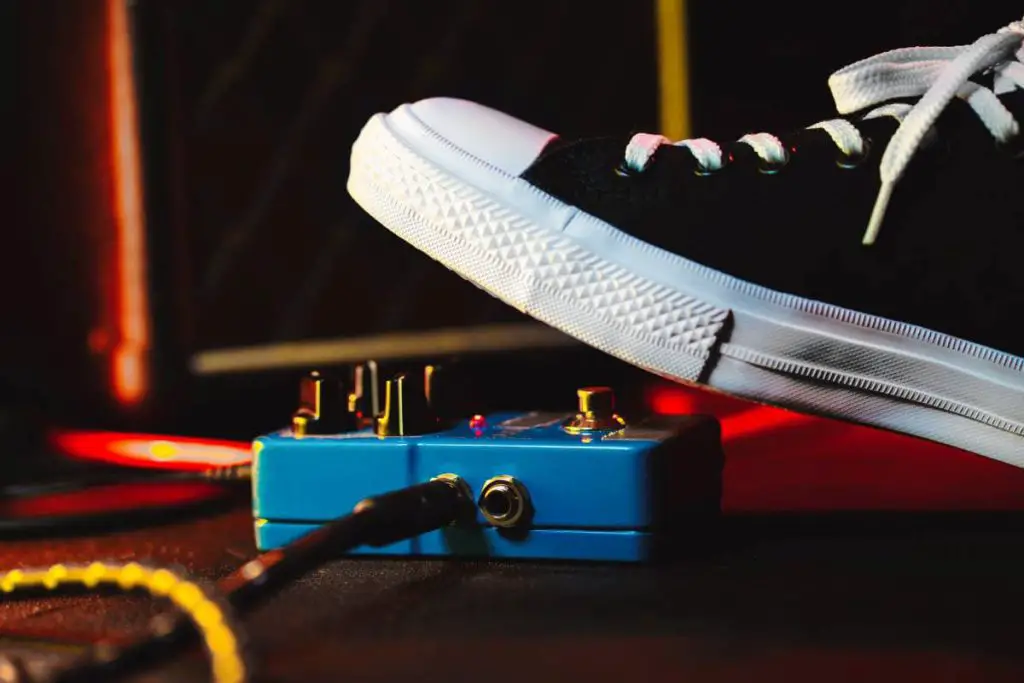
Another way to get the most out of an equalizer pedal is to increase the boost of the frequency-controllable band. Then, sweep this band across the frequency spectrum and listen for problematic frequencies, which could be the result of noisy guitar pickups.
Once you’ve identified the problematic frequency, you can bring down the gain to cut this frequency and improve the overall sound. Be mindful not to overdo it with the cutting, though!
Even if you don’t have a noisy guitar pickup, it may be worth investing in an equalizer pedal, as this is an essential piece of equipment when it comes to getting the best sound quality possible.
Conclusion
Noisy pickups can be extremely annoying and distracting for guitar players and listeners alike. Luckily, there are some measures you can take to deal with this issue, such as shielding the pickups, using a hum eliminator pedal or equalizer pedal, adjusting the power source, eliminating the ground sources, or simply adjusting the angle of the pickups. If you have a noisy guitar pickup, try one of the above tips to solve the problem and rock on!
👇😀👇NOTE👇😀👇
If you want to find out what my recommended guitar gear is, then here is what I recommend on Amazon:
- Fender Cutaway Acoustic-Electric Guitar Bundle (MY FAVORITE GUITAR)
- Snark SN-8 Super Tight All Instrument Tuner (Easiest Tuner I’ve Used😏)
- 6 String Acoustic Guitar Capo (Best CAPO for quick changes)
- Dunlop Max Grip 1.0mm Nylon Picks (Thick Guitar Pick So You Don’t Lose Grip!)
- Universal Guitar Stand (Cheap & Minimalist Guitar Stand I Recommend)
- Levy’s 2″ Wide Quick Adjust Guitar Strap (Best Guitar Strap For Any Level)

